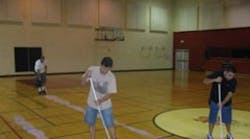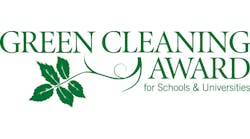Over the past few years, the Salt Lake City School District custodial department conducted pilot tests of green cleaning products at several schools to evaluate their effectiveness. As a result, they have changed not only the chemicals used in the schools, but also the cleaning and maintenance processes. The department formed an oversight committee, assessed needed changes, set goals, developed a timeframe and systematically implemented green cleaning processes and adopted greener chemicals, paper and other products and equipment. By phasing out products and methods that were inefficient and updating the processes, the department has been able to accomplish its goals with no increase to the custodial budget.
The department has made a strong commitment to “Cleaning for Health” and encourage its staff to think of themselves as environmental stewards rather than maintenance, custodial or technical staff members because every activity they perform is in some way related to providing a safe and healthy indoor and outdoor environment for the children, students and staff of the district.
For general hard-surface cleaning, they use a Green Seal-certified, hydrogen-peroxide based product. Costs are 75 percent less than the previously used product with no noticeable decline in cleaning performance. Color-coded microfiber rags are used for single purposes, such as cleaning, dusting and wiping, to reduce cross-contamination.
Hydrogen peroxide-based cleaners are used daily to clean restrooms. On a monthly basis, restrooms receive a complete application of a quaternary disinfectant applied with a foam gun to eradicate germs in the cracks and crevices. Microfiber flat mops are used because they hold more dirt and use less water. Partitioned buckets also are used to reduce cross contamination.
Handwashing dispensers in all restrooms, classrooms and faculty lounges have been changed to Green Seal-certified foaming soap dispensers with high-efficiency cartridges.
Toilet paper and paper towels are within the guidelines for LEED certification for the amount of post-consumer paper content.
The standard backpack vacuum has been upgraded with HEPA bags and filters. However, the district has not made any changes to its vacuuming procedures and schedules. In general, all vacuuming takes place after school hours.
Carpet cleaning is managed by a dedicated carpet specialist who is trained in the use of the truck-mounted extractor, chemicals and is familiar with specific building needs. Carpets are spot-cleaned as needed using hydrogen peroxide-based pre-spray and spotting cleaners followed by extractors. All carpets are cleaned annually with a truck-mounted carpet extraction system. Kindergartens, preschool and handicapped classrooms are extracted quarterly to ensure these carpets stay cleaner longer.
Gym floors are sealed using low-VOC water-based modified urethane sealer applied via a T-bar handle and microfiber head. Preparation work is cut by 75 percent using battery-powered auto scrubbers that use Green Seal-certified neutral cleaners and expend 70 percent less water. Low-VOC sealers can be maintained and revitalized using green neutral cleaners that wear about twice as long as previous finishes.
Vinyl composite tile (VCT) floors previously were maintained by deep scrubbing and recoating with at least two or three coats of wax on an annual basis regardless of need. Products with high alkaline levels were used in the scrubbing process. Now, all VCT floors are cleaned using Green Seal-certified neutral cleaners with preparation work similar to gym floors. Green finishes cost an average of 50 percent more initially but last twice as long with proper maintenance. With the new green cleaning floor finishes, the department estimates it is saving an average of $58 per building annually.
An integrated pest management (IPM) program implemented in 2005 has achieved equal or better results in controlling pests as traditional chemical-based means but in a healthier and safer way. Pest-management costs have been reduced by 75 percent, and since 2006, only 12 targeted pesticide applications have occurred in our schools with no increase in pest activity. Head custodians receive quarterly IPM training and function as IPM site coordinators. Although not required, custodial supervisors are licensed by the state as pesticide applicators.
Recycling efforts have been hit-and-miss for many years and lacked formal organization until three years ago. The district now is piloting a new single-stream recycling program under the direction of its energy and resource manager. This program is designed to divert recyclable materials, capture paper and cardboard waste as a “trash-to-cash” commodity, and reduce the total quantity of trash that a school sends to the landfill.
Rechargeable batteries from security and fire alarm panels, cell phones, radios, and power tools are recycled, and personnel are encouraged to bring all single-use throwaway batteries from flashlights, calculators, wireless devices, toilet and wash basin flush valves into the office for collection and proper disposal. They also recycle inkjet and laser printer cartridges. Although limited in number, all burned-out T12 fluorescent lamps are treated as hazardous waste and sent to a recycling center because of their mercury content.
Policies and Processes
The district is determined to develop a green cleaning “culture” that will be sustainable into the future. The procedures under which green cleaning are addressed are incorporated into a broader policy titled: Environmental Awareness and Responsibility. Policies and Procedures for the Salt Lake City School District are approved by the Board of Education; however, this draft policy is under review and has not been approved as of July 2010.
Innovations
In 2009, the Salt Lake City School District finished development of iPestManager, a Web-based pest-management tool designed to eliminate paper-based pest logs, facilitate pest-management activities and capture meaningful data to evaluate the effectiveness of the district’s IPM program.
Program Evaluation
Unannounced building inspections are conducted monthly by the custodial supervisors using a checklist of standards to evaluate the overall cleanliness and operations of facilities. The standards are based on the Cleaning Industry Management Standards (CIMS) for cleaning practices but also include safety training, recordkeeping, IPM practices, etc. Standards currently are being updated to include newer green cleaning processes.
Building custodians also monitor trash dumpsters so that scheduled pickups of partially full dumpsters are avoided and the efforts of the recycling program are maximized.
Story of innovation—Pest Management: In 2009, the district finished development of iPestManager, a Web-based pest-management tool designed to eliminate paper-based pest logs, facilitate pest-management activities and capture meaningful data to evaluate the effectiveness of the district’s IPM program.
Program Information
Number of students: 24,200
Square footage maintained: 4,389,180
Number of full-time custodians: 105
Annual cleaning budget: $4,948,619.00 (supplies/personnel)
Green cleaning team members: Ricardo Zubiate, Custodial Supervisor; Mervin Brewer, Robin Anderson, Asst. Custodial Supervisors; Greg Lebecci, Energy/Resource Mgr.


